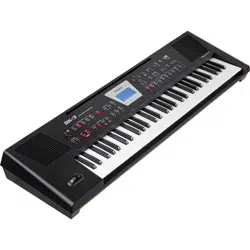Loading ...
Loading ...
Loading ...

43
17. Menu options
The BK-3’s [MENU] button provides access to the available parameters and
functions.
General procedure
1. Press the [MENU] button (its indicator lights).
The display changes to:
2. Use the [UP] or [DOWN] button to select the desired
function group.
The following function groups are available:
Function group Explanation
Internal Lyrics
Allows you to activate the display of lyrics data on the
BK-3 itself. (Only for SMF and mp3 les for which there
are lyrics data.)
Performance Edit
This function group allows you to select dierent
Tones and eects settings for the keyboard parts, the
selected rhythm, to set the Arranger’s behavior, the
split point, etc. All settings of this group can be saved
to a Performance memory. See “‘Performance Edit’
parameters” (p. 43).
Global
This function group contains parameters that apply
to all sections of the BK-3. See “‘Global’ parameters” (p.
50).
One Touch Edit
This functions allows you to edit the
ONE TOUCH memories (and to save your changes). See
“Programming Your Own ONE TOUCH Settings (One
Touch Edit)” (p. 27).
Makeup Tools
These functions allow you to edit the selected rhythm or
SMF song in an intuitive way, without caring too much
about the underlying MIDI parameters (p. 53).
MIDI
This function group allows you to edit the BK-3’s MIDI
parameters (p. 58).
Wireless
By inserting the wireless USB Adapter (WNA1100-RL;
sold separately) into the BK-3’s USB MEMORY port, you’ll
be able to use wireless compatible applications (such as
the “Air Recorder” iPhone app) (p. 62).
Factory Reset
This command allows you to load the BK-3’s factory
settings (p. 60).
Format USB
Device
This command allows you to format an optional USB
memory (p. 60).
3. Press the [ENTER] button to go to the display page where
you can edit the parameters of the selected group, or to
execute the selected command.
Internal Lyrics
The BK-3’s display can show the lyrics of Standard MIDI Files or mp3 songs
you load.
1. Load a song with lyrics data. See “Selecting a Song or
Rhythm on a USB Memory” (p. 28).
2. Select the “Internal Lyrics” group (see “General procedure”
above).
3. Press the [ENTER] button.
The internal display now shows the lyrics of the selected song (4
lines at a time).
4. At the end of the song, press and hold the [EXIT] button to
return to the main page.
‘Performance Edit’ parameters
The following parameters can be set for each Performance memory:
Function group Explanation
Tone Part View
This is where you can edit settings related to Tones
(p. 43).
Tone Part Mfx
Contains the eects parameters for the keyboard
parts (LWR, UPP) (p. 46).
Rhythm Parts
This group contains all parameters of the rhythm
parts (p. 47).
Split
This parameter allows you to change the split point,
i.e. the separation between the lower and upper
keyboard zones. (p. 47).
Scale Tune Switch
This parameter allows you to specify which parts
should be aected by the “Scale Tune” setting “Scale
Tune Switch” (p. 47).
Scale Tune
Use these parameter to change the tuning system
(“Scale Tune” (p. 48).
Key
Allows you to transpose the BK-3 in semi-tone steps
up or down (p. 48).
Arranger Setting
This function group allows you to specify where
and how the selected rhythm should scan the note
messages generated by your playing for chord
information (p. 48).
Melody Intelligent
Allows you to set the “Melody Intelligence” function
(p. 50). This page can also be selected by pressing
and holding the [MELODY INTELL] button.
Save As Default
This function allows you to save all “Performance Edit”
settings as the new defaults that will be loaded each
time you switch on the BK-3.
‘Tone Part View’ parameters
This function group can be selected using [MENU] button“Performance
Edit” “Tone Part View”.
1. Use the [INC] or [DEC] button to select the keyboard part
you want to edit (UPP (Upper), LWR (Lower).
The display shows the settings for the selected keyboard part.
2. Select and set the desired parameter(s). See “Moving
Between Windows and Setting Parameter Values” (p.
18).
The following parameters are available:
Tone
Allows you to select a dierent Tone. While selecting a Tone, you
can press a Tone selection button to select a dierent family.
Parameter Explanation
Tone The number of Tones depends on the selected family
Loading ...
Loading ...
Loading ...
